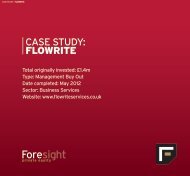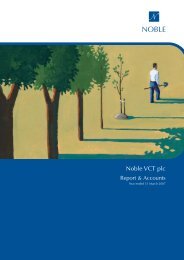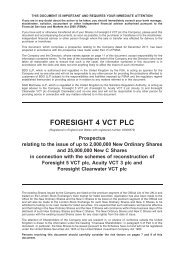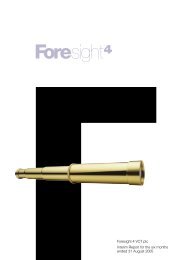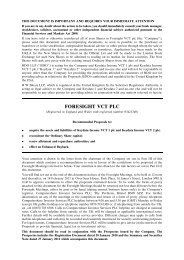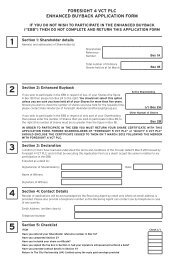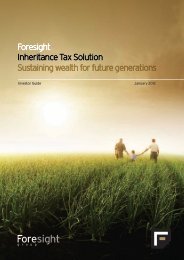Information Memorandum - Foresight Group
Information Memorandum - Foresight Group
Information Memorandum - Foresight Group
You also want an ePaper? Increase the reach of your titles
YUMPU automatically turns print PDFs into web optimized ePapers that Google loves.
APPENDIX 1: TAXATION<br />
EIS Qualifying Companies<br />
Each Investee Company in which the Fund invests must<br />
initially (i.e. at the time of issue of the Shares) not be listed<br />
on a recognised stock exchange (as defined for the purposes<br />
of EIS Relief) and there must be no ’arrangements’ in place<br />
for it to become so listed. In addition, throughout the Three<br />
Year Period, it must not be a subsidiary of, or be controlled by,<br />
another company. It must either exist to carry on a qualifying<br />
trade or else be the parent company of a trading group<br />
and there must be no “arrangements” in existence for the<br />
Investee Company to become a subsidiary of, or be controlled<br />
by, another company.<br />
A trading group is a group in which, directly or indirectly,<br />
more than 50% of the shares of each subsidiary are held by<br />
another member of the group, but any subsidiary employing<br />
any of the money raised by the issue of Shares must be a<br />
qualifying 90% subsidiary. Non-qualifying business activities<br />
(broadly, investment activities and non-qualifying trades)<br />
must not comprise a substantial part of the business of the<br />
group as a whole. The qualifying business activity for which<br />
the money is raised by the issue of Shares must be a trade<br />
carried on by a company wholly or mainly in the UK with a<br />
requirement that an Investee Company issuing the shares<br />
under the EIS must have a permanent establishment in the<br />
UK. There must also be no ‘disqualifying arrangements’ in<br />
existence (i.e. broadly tax avoidance arrangements).<br />
It is also a requirement that an Investee Company must not be<br />
’in difficulty’ when Shares are issued. An Investee Company<br />
will not be treated as ’in difficulty’ within three years of<br />
its formation or if it is able to raise funds from existing<br />
shareholders or the market.<br />
The value of the gross assets of the Investee Company<br />
and any subsidiaries must not exceed £15 million<br />
immediately before the issue of Shares and £16 million<br />
immediately afterwards.<br />
The maximum fundraising per Investee Company is restricted<br />
to £5 million in aggregate (from EIS and other state-aided<br />
risk capital sources) per year and the maximum number of<br />
full-time (or full-time equivalent) employees in the Investee<br />
Company at the time of Investment is restricted to fewer<br />
than 250.<br />
Most types of trades are qualifying trades, but the following<br />
are excluded:<br />
• Dealing in land, commodities or futures, or in shares,<br />
securities or other financial instruments;<br />
• dealing in goods otherwise than in the course of an<br />
ordinary trade of wholesale or retail distribution, or<br />
acting as a wholesaler or retailer of goods of a kind<br />
which are collected or held as investments if stock is<br />
not actively sold;<br />
• banking, insurance, money lending, debt factoring, hire<br />
purchase financing or other financial activities;<br />
• leasing, except certain lettings of ships, or receiving<br />
royalties or licence fees (subject to certain<br />
exceptional cases);<br />
• providing legal or accountancy services;<br />
24 FORESIGHT SOLAR EIS FUND 3<br />
• farming and market gardening;<br />
• forestry and timber production;<br />
• property development;<br />
• shipbuilding;<br />
• producing coal and/or steel;<br />
• operating or managing hotels or similar establishments;<br />
• operating or managing nursing homes and residential<br />
care homes;<br />
• providing services to a trade consisting of any of the above<br />
carried on by a “connected person”; and;<br />
• the generation or export of electricity benefiting from<br />
Feed-in Tariffs or similar schemes (save for anaerobic<br />
digestion, hydro and community companies and which for<br />
the avoidance of doubt does not include ROCs).<br />
Shares only qualify for EIS Relief if they are ordinary shares<br />
which do not, at any time during the Three Year Period, carry<br />
any present or future preferential right to dividends (save<br />
where the amount and date of payment of the dividend is not<br />
dependent on the decision of any party and provided that the<br />
dividends are not cumulative) or to an Investee Company’s<br />
assets on its winding up, or any present or future right to<br />
be redeemed.<br />
Fund status<br />
The Fund has not been approved by HMRC under section<br />
251 of the Income Tax Act. This means that the Investor can<br />
obtain EIS Relief in the tax year in which Investments in<br />
EIS Qualifying Companies are made by the Fund and in the<br />
preceding tax year to the extent that Carry Back Relief is<br />
claimed in respect of the Investments.<br />
The tax year in which the Investments are made through<br />
the Fund may not be the same as the tax year in which<br />
an Investor subscribes to the Fund, notwithstanding the<br />
availability of Carry Back Relief, given that the Fund Manager<br />
may invest the Fund over the course of the 2013/2014 and<br />
2014/2015 tax years. Capital Gains Tax Deferral Relief is also<br />
given by reference to the dates on which the Fund makes<br />
its Investments.<br />
When an Investment has been made in an EIS Qualifying<br />
Company and that company has been trading for at least four<br />
months, the Fund Manager will send Investors an EIS 3 Form.<br />
The EIS 3 Form can be used by an Investor to claim EIS Relief<br />
in respect of the amount invested in that company. The EIS 3<br />
Form will state the amount of the EIS qualifying investment<br />
the Investor has made through the Fund and is required<br />
when claiming EIS Relief through a personal taxation return.<br />
EIS Relief must be claimed no later than five years after<br />
31 January following the year of assessment in which the<br />
Investment was made.<br />
EIS tax reliefs<br />
To obtain the tax reliefs described below, it is necessary to<br />
subscribe for Shares in EIS Qualifying Companies and claim<br />
the relief. The summary in paragraphs (a) to (e) below is<br />
based on current law, and gives only a brief outline of the<br />
tax reliefs and assumes that the Investor is a 40% taxpayer.<br />
It does not set out all the rules which must be met by EIS



